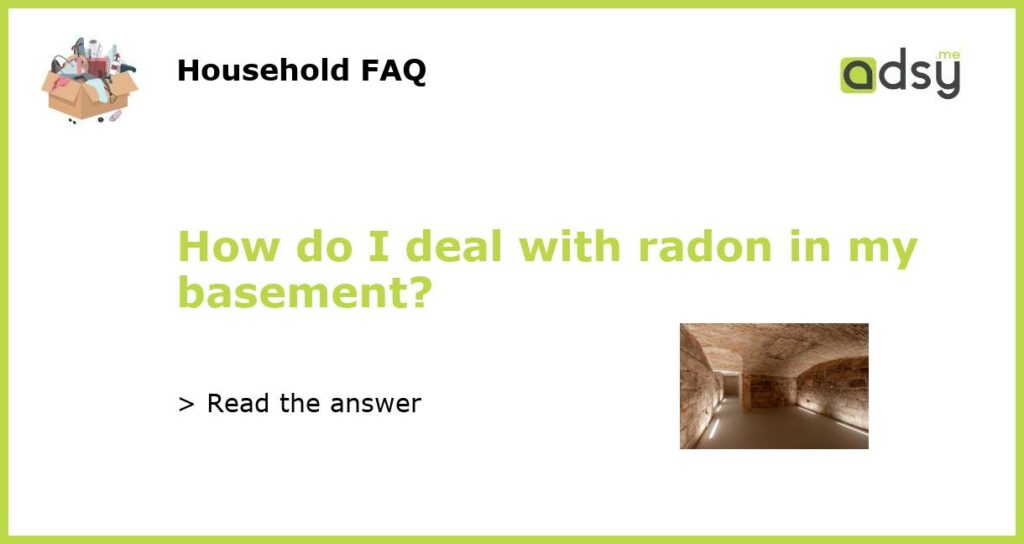What is radon and why is it a concern?
Radon is a radioactive gas that occurs naturally in the environment. It is produced by the decay of uranium, which is found in soil, rocks, and water. The gas can enter your home through cracks and gaps in the foundation, and once inside, it can accumulate in levels that are hazardous to your health.
Radon is a colorless, odorless, and tasteless gas, which makes it difficult to detect without proper testing. Prolonged exposure to high levels of radon can increase your risk of developing lung cancer, particularly if you are a smoker. In fact, radon is the leading cause of lung cancer in non-smokers and is responsible for around 21,000 deaths each year in the United States.
Given the potential health risks associated with radon exposure, it is crucial to take steps to reduce its levels in your home, particularly in the basement where radon is often most concentrated.
How to test for radon in your basement
The first step in dealing with radon in your basement is to test for its presence. There are two main types of radon tests: short-term tests and long-term tests.
Short-term tests typically run for 2-7 days and provide a quick snapshot of radon levels in your home. They are relatively inexpensive and easy to use, usually involving placing a small device in your basement for the designated testing period. However, short-term tests may not always provide an accurate representation of long-term radon exposure.
Long-term tests, on the other hand, provide a more accurate assessment of average radon levels over an extended period, usually 90 days or more. These tests are typically more expensive and require the use of a radon detector that remains in your basement for the specified testing duration.
Once you have conducted a radon test in your basement, you can determine whether further action is necessary to mitigate radon levels.
Radon mitigation techniques for your basement
If your radon test reveals elevated levels of the gas in your basement, there are several mitigation techniques you can consider to reduce radon exposure in your home.
1. Sub-slab depressurization: This technique involves installing a vent pipe and fan system beneath the basement floor to draw radon gas from the soil and expel it outside. It is one of the most effective and commonly used methods for radon mitigation.
2. Radon-resistant construction: If you are building a new home or renovating your basement, consider incorporating radon-resistant features, such as a vapor barrier and vent pipe system, to prevent radon entry into your living spaces.
3. Sealing cracks and gaps: Ensure that any visible cracks or gaps in your basement foundation are properly sealed. This helps minimize radon entry and can complement other radon reduction techniques.
4. Active soil depressurization: This method involves creating a vacuum beneath the basement floor to prevent radon from entering your home. It is particularly effective when combined with other mitigation techniques.
Hiring a professional to mitigate radon in your basement
While some radon mitigation techniques can be implemented by homeowners, others may require professional assistance. Hiring a certified radon mitigation professional can ensure that the most effective and appropriate measures are taken to reduce radon levels in your basement.
A professional radon mitigator will typically conduct a thorough assessment of your basement and determine the best approach to address the radon issue. They have the expertise and specialized equipment necessary to implement mitigation techniques correctly and effectively.
Before hiring a radon mitigation professional, it is essential to research their qualifications, certifications, and experience. Seek recommendations from trusted sources, such as local health departments or friends and neighbors who have recently dealt with radon issues. It is also advisable to request a written estimate and compare prices between different professionals.
Regular radon testing and maintenance
Reducing radon levels in your basement is not a one-time fix. It is crucial to regularly test for radon and perform maintenance on your mitigation system to ensure its continued effectiveness.
The Environmental Protection Agency (EPA) recommends testing for radon every two years, or more frequently if you have previously had elevated levels or have made significant renovations to your home.
In addition to periodic testing, it is important to maintain your radon mitigation system by regularly checking the fan, inspecting the vent pipe, and ensuring there are no obstructions or damage to the system. If you notice any issues, contact a radon professional for assistance.
By staying proactive and attentive to radon testing and maintenance, you can ensure that your basement remains a safe and healthy living space for you and your family.






